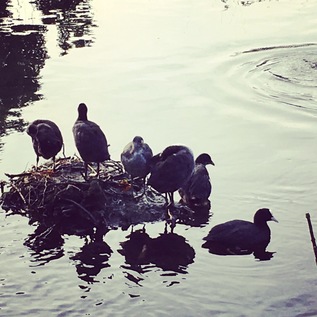Once again it was a privilege to be out early. A privilege too to descend from the former Great Eastern Hotel to the platforms at Liverpool Street for an early train - an experience I've long coveted and was glad to finally manage. The vast building edges Liverpool Street, wrapping a modern, sleek hotel inside a Victorian marvel and losing none of its charm in the process. Somewhere in the core of this network of restaurants, ballrooms and corridors was a hidden Masonic Temple which doubled as a venue. It felt like a strangely magical place, with signs which were projected onto period walls and ceilings which disappeared into the tall core of the building. Outside was a dark but thankfully dry street with only a short stretch of moderately grease-slicked pavement to navigate past McDonalds and into the station entrance. Largely free of Crossrail works at last, the hotel has regained its splendour and a little of its mystery. Many of my adventurous excursions had started and ended here at Liverpool Street - but perhaps never quite so early or in such style. After finding food and coffee I boarded the train to Enfield Town. There was a dull flicker of light in the sky, and a surprising crowd developed on the train as we sped north along the Lea Valley. My plan for today had only formed in the last few hours before sleep - there was unfinished business in the north, indeed not far from the origins of my most recent river walk...
Enfield was just waking up as I headed out of the station and into town. I slipped into a coffee shop which had opened minutes before and chugged one last hit of caffeine before setting off in earnest. The suburban High Street which I'd walked between Enfield Town and Enfield Chase stations once before was little changed, and felt less like London than ever. I began, counterintuitively by heading west. As I climbed towards the crossing of the New River, that ever present waterway which has slunk mistily through my recent wanders, I recalled my reaction at repeatedly crossing and re-crossing it on my prior visit - never realising quite what a central feature it would become in my wanderings years later. After the lines to Kings Cross passed overhead at Enfield Chase station, the road began to rise more steeply. I was climbing out of the broad Lea Valley, onto the heights that supply the tributaries on its western side, and which my recent perambulations have repeatedly haunted. The houses became larger and less cluttered together and looking back I could see Enfield sprawling east towards a green middle-distance on the other side of the valley. Ahead, the road dipped again into the gully driven by my target - the Salmons Brook. I'd rather foolishly decided that I needed to head for this crossing - somewhere between Enfield and Oakwood on the road to Cockfosters - for two reasons: firstly, because beyond here the brook meandered into open country and beyond to the M25 - this really was its first contact with London. Secondly, because I couldn't quite resist beginning a walk at a place called World's End. At the foot of the hill I found the brook passing under the surprisingly busy road via a brick bridge. Traffic hurled passed as I crossed to look into the misty middle distance beyond London. The brook curved away, hidden in a line of trees. South of the road it formed the boundary of an expensive and very private golf course. This was going to mean a long detour to pick up the route. In the event, World's End wasn't entirely as apocalyptic as it sounded - consisting mostly of a sprawlingly large chain pub and a rank of suburban shops. I plunged between them, into suburbia. My walk was beginning where the world ended...
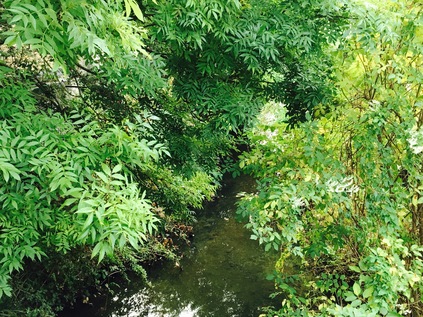
The extent of my diversion became apparent as I trudged by a large complex of schools which flanked the golf course. Once again I was heading uphill, having been led astray by what looked like a way into the park beyond the school but which was in fact a large patch of waste ground. It was still quiet and aside from a fairly gregarious population of squirrels, I was alone. Except of course for the occasional car of early shoppers heading for the vast Sainsbury's which appeared to be tucked discreetly out of sight behind a range of imposing brick frontages. This was Highlands Village - an 'executive estate' which had grown within the solid, institutional confines of the former Northern Hospital - locally known as The Pesthouse likely due to it sharing a site with Enfield Isolation Hospital. It seems the very edifices which were built to keep inmates safely within were now being used to keep undesirables out, with the carefully managed estate a sea of CCTV cameras. I decided against an early shopping trip and pressed on along World's End Lane to its junction with a familiar thoroughfare - Green Dragon Lane - starting its journey eastwards to meet Green Lanes at Mason's Corner. Once again, I marvelled at the unintentional linking of my various walks.
As I turned east I noticed I was playing a game of informal tag with a TfL van cruising the local bus stops to paste up diversion notices. I've always been weirdly embarrassed at repeated encounters like this, wondering what the likely unassuming other party will think about the fat, balding pedestrian stomping along and repeatedly catching them up. I noted with some dismay that the van turned ahead of me into Vera Avenue. I was heading this way too - because it finally got me back on track. Beyond the estate of early 20th century houses and bungalows Salmons Brook headed south east, leaving the golf course and crossing my path up ahead. I finally shook off the TfL worker as he sped away under the railway bridge at Grange Park station, where I'd alighted just a few weeks back to walk Green Lanes. From here, for a while at least, the territory was familiar so I settled into enjoying the walk. When I reached the busy crossing of Old Park Ridings I took a short detour north to the parapet over Salmons Brook. I'd been ridiculously close to this on my previous visit, but hadn't spotted the tell-tale low brick walls. The brook was a slow but steady trickle, largely clear and free of obstruction here. I headed back to my route, pottering along the same suburban streets I'd walked so recently until I came to Bush Hill. It was here that I'd looked north along the long, straight track realising it was a natural continuation of Green Lanes. Today though I turned that way with a vague intention of seeing if I could access the New River, the familiar green bank of which skirted the eastern edge of the street. Moments into the walk I discovered a curious stairway leading down from the street towards the back gardens of houses below. Figuring that Salmons Brook must pass below nearby I chanced a walk down its litter-strew steps and found myself above the brook, looking into a surprisingly ornamental stone arch. I had stumbled across the Clarendon Arch - the oldest surviving structure on the New River and something of an engineering marvel. Erected in 1682, the arch carried the brook under the New River, replacing a lead lined wooden aqueduct which had previously and precariously transported Myddleton's waterway overhead. Extended to carry a sizeable extension the embankment and Bush Hill, the portals had been re-erected and with some restoration work early this century, the structure still allowed the tiny brook to flow unobstructed. On the tiny damp viewing platform, looking into the dark tunnel I wondered how many people bothered to step down from the street to see this. I'd wager few, with most visits apparently confined to littering or illicit urination given the odour of the place. Almost opposite the stairs was a kissing gate leading onto the bank of the New River. I climbed up, and surveyed the misty view. A little weak sunshine was breaking through over the city, and the hazy morning view of ducks and green-tinged ripples was accompanied by absolute silence. It was hard not to linger here for longer.
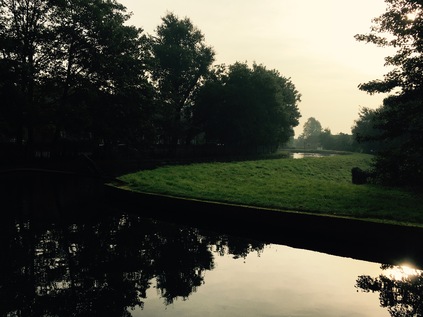
I followed the river around the corner, returning to the streets at Bush Hill Road. I then turned immediately south into a quiet housing estate to get as close to the line of Salmons Brook as possible. The estate opened into a pleasant surburban street called Berkeley Gardens which deposited me at the end of Ridge Avenue, close to where the brook crossed under the street. I detoured south, planning to make my crossing above the water, and found the brook now in culvert. To the west, a concrete access ramp ran along the line clearly distinguishable line of the waterway and, after a fraught crossing of the road, the eastern course was marked by a rough, litter-strewn grassy void between houses. I felt further from the water than ever and began to question how much I'd actually see of Salmons Brook today. Whatever I did now, I'd have to circle the route which the brook took across the suburbs here. I opted to head south along Church Street, and then onto Little Bury Street which would allow me to cross the brook again. This time, tucked into the narrow street which was little more than an access for Edmonton County School, I found the brook trickling in the open air under a tiny bridge and evidently subject to ongoing works to shore up its broad banks. Encouraged, I turned east again with the intention of exploring Bury Lodge Gardens. This urban park is divided into two distinct parts - a formal garden, carefully laid in colourful and seasonal beds with arches and structures for climbing plants around tidy pavements and benches, and a rough grassed area leading down to the brook. I crossed both and found myself separated from the dark water by a palisade fence. I wandered the edge of the park before finding myself back on Bury Street West and pounding the footpaths once again. I was beginning to feel the effects of the walk, and with the brook now running some way to the south, I found myself beside the rush of the A10 at a tiny parade of shops. The main road curved away to the south, cutting across allotments which entirely enclosed Salmons Brook, while ahead of me lay the edge of Edmonton.
I've managed to avoid walking in Edmonton to any great degree. That's not by design, more because my routes tend to radiate in or out of the city along the valleys carved by rivers or roads, and Edmonton sits squarely between these. From the river towpath the only great landmarks are the tower blocks at Edmonton Green which glower over the suburban streets, along with the audible and olfactory footprints of the vast waste incinerator. However, Salmons Brook cuts directly across the area on its journey to the Lea once I'd crossed the Great Cambridge Road I was very clearly in new territory. I plunged into suburbia almost eagerly - there were points here where the brook ought to be visible before disappearing underground, and now the clouds were closing in overhead the streets offered a relatively sheltered walk for a while. As I zig-zagged into Rugby Road I was halted by the sudden presence of one of the Edmonton Green towers directly ahead of me. Even at a distance it seemed vast - Pennine, Mendip and Grampian House are each twenty-five storeys high and almost exactly the same age as me, their survival stemmed from Enfield's policy of renewal and refurbishment. Among the tiny red-tiled roofs of the side streets with every possible space crammed with homes, the towers seemed cold and glassy, dark sky visible through their open-cornered balconies. I set off again, and note by a trick of perspective that the towers soon disappear. I wonder if I've been witness to some sort of suburban mirage? For the first time here I find myself doubling back too - a public footpath covering the route of Salmons Brook crosses west to east here, but I don't take it imagining my walk will be better served by taking the long way around. Instead I return and take the path, a concrete phantom of the brook beneath, which deposits me at the foot of an almost worryingly decayed footbridge over the railway. I pick my way through the fly-tipped detritus which lines the path and gingerly ascend the rotting wooden steps. The high, narrow bridge deposits me in a similarly filth-strewn alley which opens onto a similar suburban street - but a notch down the ladder of gentrification. I'm being trailed by a black BMW which shudders with the low-end of an unidentifiable post-musical emission. For the first time in a long time I feel paranoia creep over me and I taste the metallic tang of adrenalin. The car slowly passes, the driver disdainfully regarding me as it slowly bucks over the speed bumps before screeching the few yards to the next set of traffic-calming measures. I turn gratefully south, following the railway towards the now ominously overbearing towers. The street becomes semi-industrial, and amid the car repair units and storage spaces I spy a small bridge over the brook. The view opens, into a wide, unused and likely unusable space between new and old developments and suddenly, in the midst of it Salmons Brook emerges in a concrete trough. I can walk its bank for a few yards, ignoring the hi-vis clad lurker smoking away his work-break where an Environment Agency access ramp leads down to the culvert. The stream is greenish and clogged with branches which snag on the concrete beam dividing the channel in two, but this doesn't dissuade a small cluster of birds from resting on the driftwood. Up ahead the stream disappears into a black tunnel opening above which is the partially refurbished Edmonton Green shopping centre. The tower blocks lean over me at close quarters, and the strange paranoia isn't diminished by proximity. Crossing the busy street and navigating the bus station leads me to the entrance to the shopping centre. The outer layers of the centre are tidy, shinily clad walls of reflective colour, but once under the bulk of the towers, the inner concrete shell is revealed. The walkways open into a vast covered market with a glass roof through which a jagged, staggered vision of the towering blocks fractures. I turn aside and walk a slightly crestfallen precinct towards a huge ASDA which appears to have landed beside the centre.
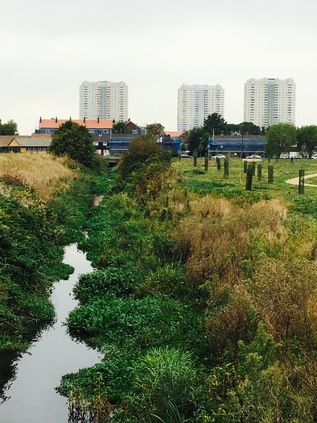
After stocking up on provisions I turn east again, figuring that the walkway beside ASDA is in fact the line of the Brook. At the end of the pedestrianised zone at the crossing of Plevna Road, I'm rewarded with a view ahead of a long, open stretch of waterway with a surprisingly tidy, recently built path beside it. The sky is a dark, purple churn of clouds now and I'm amazed I've not been caught in a shower yet. The low autumn sun has almost completed an arc overhead during my walk, and now I find myself walking towards an inky sky in the east. The path is long, straight and largely free of other pedestrians once I'm out of the gravity of Edmonton Green, while the channel containing the Brook is carved surprisingly deep and already cluttered with debris in places. The path runs tightly along the northern edge of a cluster of cemeteries, the largest being the privately owned Tottenham Park which opened in 1912 as a pauper's graveyard. This cemetery now appears to be mostly populated by Middle Eastern family graves, while a rotting and forlorn chapel crumbles among them. I snap a picture - white marble and crescent carvings set against the brick and verdigris of the chapel - but realise that in the wrong hands, it would provide the perfect out-of-context symbol for the far right. Tucked in a corner of the site is Edmonton Federation Cemetery, a somewhat earlier patch reserved for Jewish burials opened in 1889 on land donated by Lord Montagu. His name lives on in the busy road passing the site, and in the recreation ground across the street which doubles as a flood control area for the brook. Opposite the understated cemetery gates and sandwiched between Montagu Road and the Lea Valley railway lines, the green space is overshadowed by the reek from the Incinerator nearby. I walk the line of the brook until it disappears under the railway, turning south to circumnavigate the pools and hollows designed to manage the brook's surging waters when storms hit. Looking back west across the largely flat suburban landscape, the towers of Edmonton Green still loom large. It feels like there is no escape from their gravity. A little rain begins to fall, and I find myself trudging along a street of industrial units, the pavement slick with a coating of old dust and fresh rainwater. Back on Montagu Road I turn south, noting the long straight path leading back to the shopping centre, occupying the route of the former railway to the remarkably named Lower Edmonton Low Level. The crossing gates here are long gone, but the ghost of the railway is preserved in the arrow-straight footpath. The rain is falling a little harder now, and I seriously consider calling it quits at the next bus stop. It feels like the Lea's tributaries might defeat me again - so, of course I don't, and as a single-decker bus splashes past me without stopping I resolve to push on. A low drone up ahead signals the arrival of my old friend, the North Circular. Sweeping in on a viaduct, it stoops only for long enough for sliproads to join its main carriageway before arcing east over the Lea Valley. At the end of Montagu Road some sorry-looking but clearly once grand buildings are boarded up and marked for sale, but I can't imagine who would buy them with the concrete road mere feet from the upper storeys. Across the street is an entrance to the rather forlorn looking Kenninghall Open Space which occupies an oddly shaped island of space between the roads which loop up to the North Circular. I cautiously wander in, finding myself in a surprisingly quiet tunnel of green which appears to be abandoned. Broken benches harbour litter and the path cracks as roots strive for air in the polluted ground. The path curves south and delivers me to the base of the bridge. I cross the street and make a speculative but ultimately pointless detour into Albany Road which rather than leading to what appeared to be a patch of promising wasteland, now ends at the muddy security checkpoint outside a new development site. I retrace my route to the flyover, tired but at least drying out now, and climb the slip road. The view from the bridge is remarkable - a retail jungle to the north with a Premier Inn besieged by the tangle of roads, shuddering with the traffic. Looking south, a broad open marsh runs along the course of the railway. In the hazy distance, swathed in low cloud and ominously back-lit, the shapes of city towers can just be made out. A family who I've passed on the ascent re-cross my path once or twice as I stop to take pictures. A curious young boy, hangs back to watch me pointing my camera at the horizon. When his mother notices the tug of his arm on the pram as he dawdles, she turns and spits "Don't look at the weird man, he's takin' pictures of nuffink!". Half way across the bridge, I spot the curve of concrete emerging from under the road. This is another old friend: Pymmes Brook, and this is part of a walk I should have completed a month or two back. The Brook makes a tight left turn in the channel and passes under the staircase which descends from the bridge to the carpark of Tesco Extra. I descend, the smell of the slow moving brook beneath rising to meet me. Anyone who sees me here now, smiling like an idiot as he links up the geography of this retail park landscape, would likely worry - either for themselves or for me. My flagging energy returning, I make a brisk beeline for the store.
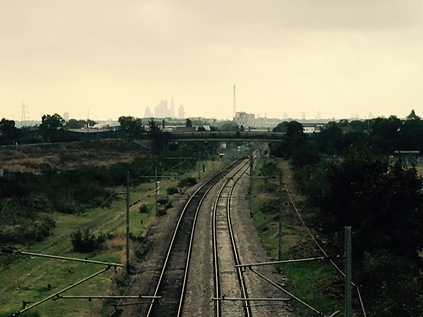
The last leg of the walk is tough going physically, but is surprisingly rewarding nonetheless. Thinking how far away the heights of Enfield seem now, I navigate the access roads from Tesco and head for the vast blue cube of IKEA. Their entrance road is flanked by broad, well-surfaced pavements but oddly the fence encloses these, leaving a gap only wide enough to accommodate the carriageway. I slip around the gate and walk close to the hedge and fence which divides me from the brook. At a point somewhere behind this fence the Salmons Brook and Pymmes Brook converge and form a single channel heading for the Lea. I can't formally honour the confluence - but I find a clear gap in the hedge where an access gate opens onto the brook and poke my camera through. I see the familiar concrete two-channel trench leading off into the middle distance. As I pick my way back to the road through the patchy and poorly-established grass of the verge, two adolescent IKEA workers approach me. They're dry-mouthed and clumsy with acne and apprehension as they ask what I'm doing here? I try to calmly explain that I'm taking pictures of the brook - one begins uncertainly "What brook?" but the other quickly and more confidently splutters out "You can't, it's our property". Amused more than annoyed, I carefully point out the Environment Agency signs, and they counter with "But you're on our land". I explain that I can't imagine what I'm doing wrong, but that I'm leaving anyway. As I wander across the car park they insist on escorting me to the edge of the site, walking solemnly a few steps behind me, looking at the pavement and resolutely not conversing with me. I don't rush - but as I pass the bus stop I see them back at the gateway, waiting for me to leave. They look mortally embarrassed and out-of-place in their gaudy blue uniforms which belong inside among the colourful plastic salad tossers, rather than out here against the grey skies. It's a short walk to Leeside Road where I turn aside and head for the Pymmes Brook Trail. Walking through Tottenham Marshes between the canal boats on the River Lea Navigation and the channel which contains the collective waters of two of my incomplete walks now, I'm on familiar ground. I've walked this valley before, and I know the terrain. My feet feel heavy and tired, and while I'm eager to fall onto a train, I'm equally reluctant to stop walking today. I think about continuing to Lea Bridge, or even further - but common sense prevails. I'm tired and I need to make sense of the walk before I head back to reality. The path twists its way into the narrow strip of land between the brook and the River for a final stretch and I decide to walk on, under the road bridge at Tottenham Lock, to the point where four summers ago I'd first spied Pymmes Brook leaving the Lea. A boom trapped the water leaving the brook, gathering little islands of twigs with halos of coruscating pollutants. Waterfowl leapt from island to boom and back while the brooks churned against the plastic barrier, unable to complete their journey until the floods came again. My journey though was done. I regrouped my aching limbs and climbed slowly up the towpath steps back to the road to head for Tottenham Hale station. Once again my walk had brought discrete topographies into alignment. I felt like I understood the valley just a little better. It was time to head homeward.
You can see a gallery of images from the walk here.
Lost::MikeGTN
I've had a home on the web for more years than I care to remember, and a few kind souls persuade me it's worth persisting with keeping it updated. This current incarnation of the site is centred around the blog posts which began back in 1999 as 'the daylog' and continued through my travels and tribulations during the following years.
I don't get out and about nearly as much these days, but I do try to record significant events and trips for posterity. You may also have arrived here by following the trail to my former music blog Songs Heard On Fast Trains. That content is preserved here too.
